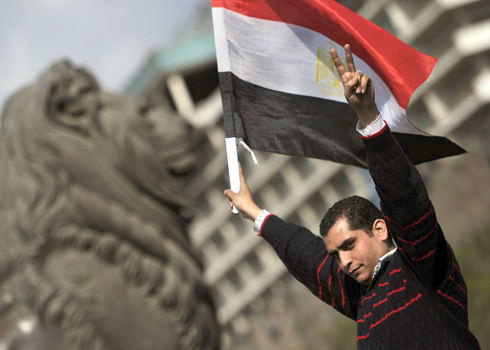A new study from the University of Washington suggests that social media, in the form of millions of tweets, played a “central role” leading up to the revolutionary movements that toppled dictators in Tunisia and Egypt earlier this year.
Philip Howard, an associate professor of communication at UW, headed the research team that analyzed more than three million tweets along with several thousand videos and blog posts to produce the study, titled “Opening Closed Regimes: What Was the Role of Social Media During the Arab Spring?”
Also contributing to the PITPI study were Muzammil Hussain, Will Mari, and Marwa Mazaid of UW, Deen Freelon of American University, and Aiden Duffy of Amazon Web Services.
“Digital media is clearly used for catching dictators off guard,” Howard said in a conversation with TPM’s Idea Lab. “Most dictators don’t have social media strategies.”
The team, which included translators, searched for content such as the frequency of the word “liberty” to conclude that “conversations about revolution often preceded major events on the ground.”
In one example, the number of tweets from Egypt went from 2,300 to 230,000 in the week leading to the resignation of President Hosni Mubarak.
The study was performed under the auspices of the Project on Information Technology and Political Islam (PITPI).
Howard is the director of PITPI and author of Digital Origins of Dictatorship and Democracy (Oxford University Press).
In some ways, the team’s research was straightforward. Twitter has since changed its policies, but at the time of the unrest earlier this year its archives were freely available for non-commercial use. Each tweet has a stamp that indicates its time and date of origin.
Determining whether the tweets originated from Egypt and Tunisia presented some difficulties, though, according to Howard.
Some users provided their country of origin on their profiles, even down to the city or longitude and latitude, but many did not, presumably to evade detection. Howard’s translators deduced the origin of many of the tweets by their content.
The translators also flagged tweets that contained obvious lies or misrepresentations.
“In other countries such as Bahrain, Syria, and Libya the security services were putting lies on Twitter to round people up,” said Howard, who said that according to the evidence these practices – such as falsely describing the location of a rally and then arresting those who show up there – were relatively rare in Egypt and Tunisia.
Howard also explained that ideally, text messages would have been a focus of study, since the vast majority of people in Tunisia and Egypt have access to mobile phones and communicate by texting. However, the raw data for texting is unavailable.
Twitter usage can be used as a proxy for changes in the rate and content of text messaging, though Howard cautioned that Twitter users may be skewed toward the intellectual or elite sectors.
Despite the caveats, Howard credits social media with creating a crucial communication platform that circumvented the restrictions of conventional media.
“People who shared interest in democracy built extensive social networks and organized political action,” Howard stated in a UW report. “Social media became a critical part of the toolkit for greater freedom.”
Howard has been studying the role of digital media in civil unrest since 1998, when students in Indonesia used mobile phones to communicate information about popular protests leading up to the abdication of President Suharto.
In his interview with TPM’s Idea Lab, Howard noted the similarity of the uprisings in Indonesia with those in Tunisia and Egypt, though the former occurred years before Twitter, texting, Facebook, and blogging became commonplace.
“The tools change, but the impact is the same,” he said.






